Mid-Project Rubric Review Transcript
Instructor: Lauren Hobbs
+++ 00:00:06 +++
Card:
Educate Texas supports rigorous, college ready standards for all Texas students. The Common Instructional Framework is part of that approach.
Card:
Common Instructional Framework
•Collaborative Group Work
•Writing to Learn
•Scaffolding
•Questioning
•Classroom Talk
•Literacy Groups
Card:
Mid-Project Rubric Review
+++ 00:00:27 +++
Lauren Hobbs: All you're doing is listing what you think is the easiest part and the most difficult part of our geometry project so far.
Lower Third:
Lauren Hobbs
9th Grade Geometry
SheldonEarly College High School, Houston, Texas
Lauren Hobbs: My name is Lauren Hobbs, I teach Geometry at Sheldon Early College High School in Houston, Texas.
Lauren Hobbs: We have one week until our project is due.
+++ 00:00:45 +++
Lauren Hobbs: Today we did a Mid-Project Rubric Review in order to get the kids on tract for their final project. Each rubric was different. The architecture project had students building many different 3D shapes, and they had to find the volume and surface area, and then convert centimeters to feet. The soccer ball had students finding surface area and then volume, and then they had to compare it to the actual size of a real soccer ball. The song or poem had students analyzing different geometric topics, and then making sure they understood all the geometric vocabulary.
+++ 00:01:17 +++
Lauren Hobbs: I'll give you about 30 more seconds to work on your warm-up, okay?
Lauren Hobbs: We did use Common Instructional Framework in this lesson.
Card:
Writing to Learn
Lauren Hobbs: We start with a low-stakes Writing to Learn for the warm-up. Write about what they think is the most difficult part of the project, and the easiest part of the project so far, and just to kind of get them thinking about their projects.
+++ 00:01:35 +++
Lauren Hobbs: Let's hear it from one of each kind of group? What about a rap person?
Student: The difficult part was to make the rap rhyme with the song lyrics.
Student: And staying on topic.
Lauren Hobbs: Staying on topic?
Students: Yes.
Lauren Hobbs: They have to share with the group. That way they can compare with each other, what their thoughts are at this point.
Lauren Hobbs: Did anybody think the calculations were the hardest part on your architecture or your soccer ball?
Student: Mm hm.
+++ 00:02:01 +++
Lauren Hobbs: Has anybody not gotten to the calculations yet? Okay.
Lauren Hobbs: After that, they take their mid-project rubric reviews. I've noticed some of the kids have gotten stuck on the fun part of the project.
Lauren Hobbs: So what you're going to do with this, is you're going to look at it-- you're not rating yourself right now-- and so you're going to take this. For example, if I'm doing the soccer ball project, and it says "Calculations," I'm going to write in there what I think, if I were to get full credit, what would that look like?
Lauren Hobbs: If I get full points in calculation, I need to make sure I have all the surface area, and the volume. If I get full points for creativity, this is what I need to include.
+++ 00:02:37 +++
Lauren Hobbs: And then how would that help you with the next one?
Card:
Questioning
Lauren Hobbs: Why would making that table help you?
Student: It would give me the correct measurement.
Lauren Hobbs: Mm hm, make it nice and easy, right?
Student: Mm hm.
Lauren Hobbs: Very good.
+++ 00:02:47 +++
Lauren Hobbs: They're not going to get a Mid-Project Rubric Review from a college professor. So if they don't keep themselves on track, nobody's going to do it for them.
Lauren Hobbs: What are two things that you can do to move towards maximum points, and then you're going to ask a peer, "What is one idea that you could have that can help?" So I'm going to put some guidelines on the board for you. So you're going to be positive with your comments and critiques. Why do you want to be positive when you're critiquing somebody else?
Student: Constructive criticism.
+++ 00:03:13 +++
Lauren Hobbs: Constructive criticism. Are there any questions? Okay, can we get started?
Card:
Collaborative Group Work
Student: I made this one the point of reflection. Selected this one. Well, first I made the polygon of it by filling it in. And then I reflected it off of this line, and I selected this one.
Student: So basically when you move the line, it reflects it so that way you can make it move back and forth?
Student: Yes.
Student: Try, try, try, try. Don't believe it just try. This .
+++ 00:03:43 +++
Lauren Hobbs: The rubric itself is a big scaffold, I think as long as you keep referring back to that rubric. And when they ask a question, "What do I need? What's my skill factor?" They're learning to reflect on their own learning. They're learning to work well with other people. They're learning how to really talk within a classroom setting using think Common Instructional Framework. And I think it's a really great experience for them.
+++ 00:04:06 +++
Lauren Hobbs: Okay, so what we're going to do is you need to pick which project up to this point is the most developed, and you're going to show the class, "This is what it looks like so far, and this is where we imagine it going by this time next week." Because it's due a week from tomorrow.
Lauren Hobbs: I'm teaching them skills that they're going to need in the future.
Student: Three cubes on this side, three cubes on this side. It's going to have a rectangular prism. Three cylinders in the back with cones on top.
+++ 00:04:33 +++
Student: I have the soccer ball, and I'm almost done building it. And I'm going to just add the equations and finish the calculations for it.
Student: I have all the shapes cut out, and all the equations done already, like answered, and that's all.
Student: There's going to be a pyramid, and another-- a cylinder and a cone. And that's it.
Student: We are doing a song, but it's not finished. "Four sides, four vertices, four angles, it's nothing. Huh! Convicts in concave, yes got it right, I'm studying. Hm. This song's for the math student who can't get it right. Huh. Bang your head in math class, up studying all night. Ah!"
+++ 00:05:19 +++
Lauren Hobbs: I think they're all going to complete their project, and they're going to do it well. I think they really understand where they need to be by the end of the project based on this Mid-Project Review. And they have a better understanding of where they need to be by this time next week.
Lauren Hobbs: Bye, Ricardo, bye, everybody! Thank you so much. Bye!
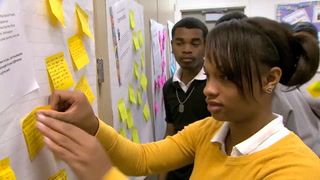
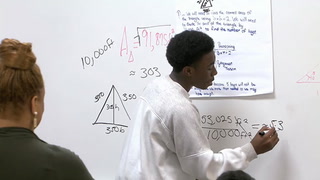

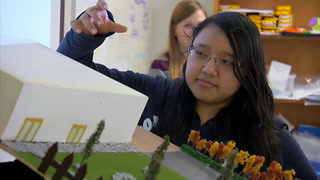
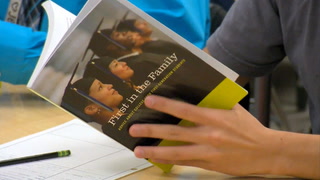
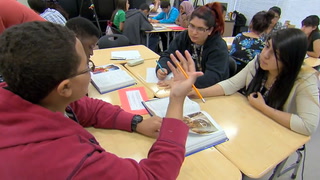








9 Comments
Dee Lynch Jun 15, 2014 1:46am
Tere Hirsch Jun 8, 2014 5:42pm
Murrell Stewart Feb 1, 2014 11:16pm
Laura Diaz Feb 1, 2014 3:04pm
Purushothaman J Nov 17, 2013 8:31am